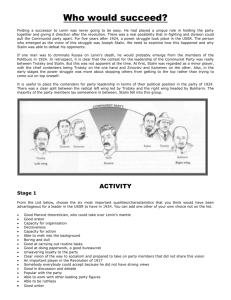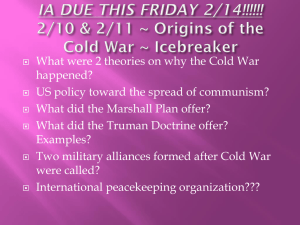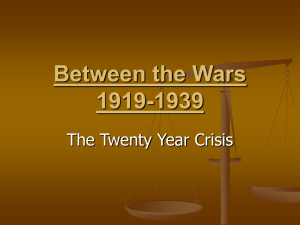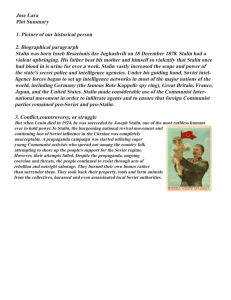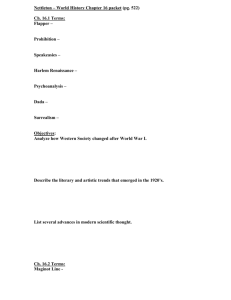Name________________Date Due_12_07_Thursday. Posted on
advertisement
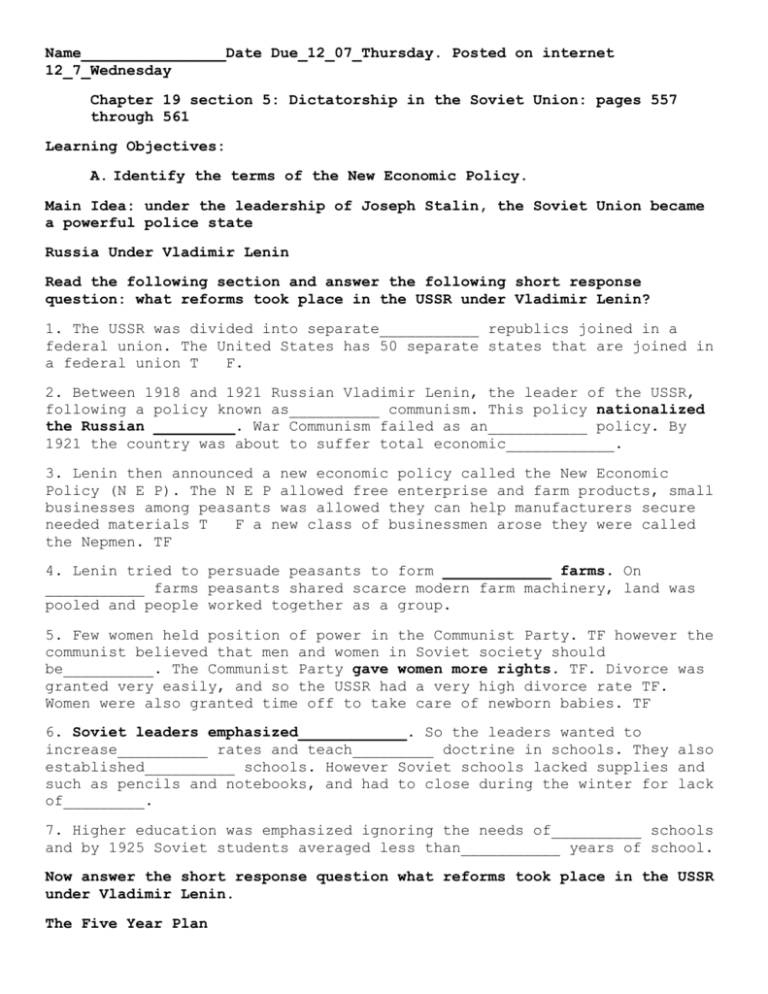
Name________________Date Due_12_07_Thursday. Posted on internet 12_7_Wednesday Chapter 19 section 5: Dictatorship in the Soviet Union: pages 557 through 561 Learning Objectives: A. Identify the terms of the New Economic Policy. Main Idea: under the leadership of Joseph Stalin, the Soviet Union became a powerful police state Russia Under Vladimir Lenin Read the following section and answer the following short response question: what reforms took place in the USSR under Vladimir Lenin? 1. The USSR was divided into separate___________ republics joined in a federal union. The United States has 50 separate states that are joined in a federal union T F. 2. Between 1918 and 1921 Russian Vladimir Lenin, the leader of the USSR, following a policy known as__________ communism. This policy nationalized the Russian _________. War Communism failed as an___________ policy. By 1921 the country was about to suffer total economic____________. 3. Lenin then announced a new economic policy called the New Economic Policy (N E P). The N E P allowed free enterprise and farm products, small businesses among peasants was allowed they can help manufacturers secure needed materials T F a new class of businessmen arose they were called the Nepmen. TF 4. Lenin tried to persuade peasants to form ____________ farms. On ___________ farms peasants shared scarce modern farm machinery, land was pooled and people worked together as a group. 5. Few women held position of power in the Communist Party. TF however the communist believed that men and women in Soviet society should be__________. The Communist Party gave women more rights. TF. Divorce was granted very easily, and so the USSR had a very high divorce rate TF. Women were also granted time off to take care of newborn babies. TF 6. Soviet leaders emphasized____________. So the leaders wanted to increase__________ rates and teach_________ doctrine in schools. They also established__________ schools. However Soviet schools lacked supplies and such as pencils and notebooks, and had to close during the winter for lack of_________. 7. Higher education was emphasized ignoring the needs of__________ schools and by 1925 Soviet students averaged less than___________ years of school. Now answer the short response question what reforms took place in the USSR under Vladimir Lenin. The Five Year Plan Read the section below and try to answer the short response question what affect did Stalin's five-year plan have on Soviet life? 8. The Vladimir Lenin dies in 19___. Leon__________ and Joseph________ struggle for power. Trotsky and Lenin disagreed as to the best way to make___________ work around the world. Trotsky was a strict Marxist; Trotsky wanted communism and revolution to take place all over the world. TF Stalin wanted socialism to work first in the USSR and then spread the revolution to the rest of the world. TF 9.___________ emerges as the leader and has___________ murdered in Mexico. In 1928, Stalin disbands the N E P and returns to a command economy, and a command economy the government controls all__________ decisions. No Adam Smith here, no one invisible hand. T F 10. In 1928 Stalin releases the first_________ year________. For the USSR economy. The plan set________ agricultural, industrial and social goals for the next______- years. Stalin wanted the output of ______ to triple,________ the production of coal and oil, wanted the exports from_________ to pay for new modern machinery. 11._________ farms were a disaster. The______ your plans actually__________ farm production. Millions of people died as a result of famine and crop failure. TF. However steel production increased dramatically TF.___________ goods decreased. No consumer goods, and food became very scarce, Stalin's focused the USSR on expanding heavy industry especially____________ production. Now answer the short response question what affect did Stalin's five-year plan have on Soviet life Stalin's Dictatorship Now read the section below and answer the short response question: what was the relationship between the ordinary Soviet citizen and the state during the era of Stalin's rule? 12. Under Stalin the Soviet people were ruled by_______. People had to obey the demands of the__________ or face imprisonment or_________. The Soviets were highly controlled. TF 13. Soviet officials discouraged___________ worship and seized the property of the churches and Jewish houses of _______. priest rabbis and ministers were__________. The works of artists musicians, and writers were subject to government_________. Artists were ordered to produce works of" socialists realism" to prove they were_____ to the state. 14. On paper the Soviet government appears to be_________. But most of the power really lay in the hands of the__________( political Bureau). The parliamentary body, was known as The Supreme__________. The Supreme Soviet elected the Politburo TF. Stalin was a dictator with almost complete control. TF 15. A large-scale elimination of party members is called a__________. In 1934 Stalin ordered a purge, because someone assassinated an official of the___________ party. People were imprisoned without a trial TF. By 1939 Stalin had arrested, deported, imprisoned in forced labor camps, more than 5 million people. 16. Foreign policy during 1920s and 1930s was__________. The Soviets supported the Communist international or_________. This organization was founded by Lenin to spread the___________ revolution throughout the world. The Comintern worked to overthrow democracies by urging workers to rebel. The Comintern caused fear and suspicion outside the Soviet Union. TF. On the other hand Lenin wanted these other nations to accept him. TF. Now answer the short response question what was the relationship between the ordinary Soviet citizen and the state during the era of Stalin's rule?

